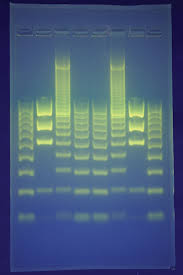


 النبات
النبات
 الحيوان
الحيوان
 الأحياء المجهرية
الأحياء المجهرية
 علم الأمراض
علم الأمراض
 التقانة الإحيائية
التقانة الإحيائية
 التقنية الحيوية المكروبية
التقنية الحيوية المكروبية
 التقنية الحياتية النانوية
التقنية الحياتية النانوية
 علم الأجنة
علم الأجنة
 الأحياء الجزيئي
الأحياء الجزيئي
 علم وظائف الأعضاء
علم وظائف الأعضاء
 الغدد
الغدد
 المضادات الحيوية
المضادات الحيوية|
أقرأ أيضاً
التاريخ: 18-3-2021
التاريخ: 8-2-2018
التاريخ: 27-4-2016
التاريخ: 19-5-2021
|
Are fingerprints determined by genetics?
Each person’s fingerprints are unique, which is why they have long been used as a way to identify individuals. Surprisingly little is known about the factors that influence a person’s fingerprint patterns. Like many other complex , studies suggest that both genetic and environmental factors play a role.
A person’s fingerprints are based on the patterns of skin ridges (called dermatoglyphs) on the pads of the fingers. These ridges are also present on the toes, the palms of the hands, and the soles of the feet. Although the basic whorl, arch, and loop patterns may be similar, the details of the patterns are specific to each individual.
Dermatoglyphs develop before birth and remain the same throughout life. The ridges begin to develop during the third month of fetal development, and they are fully formed by the sixth month. The function of these ridges is not entirely clear, but they likely increase sensitivity to touch.
The basic size, shape, and spacing of dermatoglyphs appear to be influenced by genetic factors. Studies suggest that multiple genes are involved, so the inheritance pattern is not straightforward. Genes that control the development of the various layers of skin, as well as the muscles, fat, and blood vessels underneath the skin, may all play a role in determining the pattern of ridges.
The finer details of the patterns of skin ridges are influenced by other factors during fetal development, including the environment inside the womb. These developmental factors cause each person’s dermatoglyphs to be different from everyone else’s. Even identical twins, who have the same DNA, have different fingerprints.
Few genes involved in dermatoglyph formation have been identified. Rare diseases characterized by abnormal or absent dermatoglyphs provide some clues as to their genetic basis. For example, a condition known as adermatoglyphia is characterized by an absence of dermatoglyphs, sometimes with other abnormalities of the skin. Adermatoglyphia is caused by mutations in a gene called SMARCAD1. Although this gene is clearly important for the formation of dermatoglyphs, its role in their development is unclear.




|
|
|
|
تفوقت في الاختبار على الجميع.. فاكهة "خارقة" في عالم التغذية
|
|
|
|
|
|
|
أمين عام أوبك: النفط الخام والغاز الطبيعي "هبة من الله"
|
|
|
|
|
|
|
قسم شؤون المعارف ينظم دورة عن آليات عمل الفهارس الفنية للموسوعات والكتب لملاكاته
|
|
|